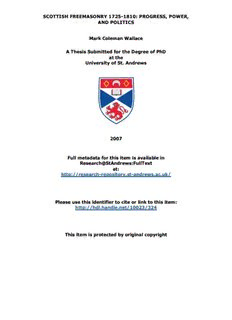
Mark Coleman Wallace PhD Thesis - University of St Andrews PDF
Preview Mark Coleman Wallace PhD Thesis - University of St Andrews
>0;??6>5 3=228/>;9=B &+’*"&,&%- <=;4=2>>! <;A2=! /91 <;76?60> 8CRL 0PMGNCO ACMMCEG / ?JGSKS >UDNKTTGF HPR TJG 1GIRGG PH <J1 CT TJG @OKVGRSKTY PH >T# /OFRGWS ’%%+ 3UMM NGTCFCTC HPR TJKS KTGN KS CVCKMCDMG KO =GSGCREJ.>T/OFRGWS-3UMM?GXT CT- JTTQ-$$RGSGCREJ"RGQPSKTPRY#ST"COFRGWS#CE#UL$ <MGCSG USG TJKS KFGOTKHKGR TP EKTG PR MKOL TP TJKS KTGN- JTTQ-$$JFM#JCOFMG#OGT$&%%’($(’) ?JKS KTGN KS QRPTGETGF DY PRKIKOCM EPQYRKIJT SCOTTISHFREEMASONRY1725-1810: PROGRESS,POWER,ANDPOLITICS MARKCOLEMANWALLACE Thesis submittedforthedegreeofPh.D. UniversityofSt Andrews, 10April 2007 For UncleDennis ii Declarations (i) I,MarkColeman Wallace,herebycertifythat this thesis, whichis approximately 80,000words inlength,has beenwrittenbyme,that it is therecordof work carriedout bymeandthat it has not beensubmittedinanyprevious application forahigherdegree. Date………………. Signatureofcandidate…………………….. (ii) Iwas admittedas a researchstudent inSeptember 2001andas a candidate forthe degreeofPh.D.inSeptember2002; thehigherstudyforwhichthis is arecord was carriedout intheUniversityofSt Andrews between2001and2006. Date………………. Signatureofcandidate…………………….. (iii) Iherebycertifythat thecandidatehas fulfilledthe conditions oftheResolution andRegulations appropriateforthedegreeofPh.D.intheUniversityofSt Andrews andthat thecandidateis qualifiedtosubmit this thesisinapplicationfor that degree. Date………………. Signatureofsupervisor…………………... (iv) Insubmittingthis thesis totheUniversityofSt Andrews Iunderstandthat Iam givingpermissionforit tobemadeavailableforuseinaccordancewiththe regulations oftheUniversityLibraryforthetime beinginforce,subject toany copyright vestedintheworknot beingaffectedthereby. Ialso understand that the titleandabstract will be published,andthat acopyofthe workmaybemadeand suppliedtoanybonafide libraryorresearchworker. Date………………. Signatureofcandidate…………….………. iii Abstract Modernfreemasonryemergedin Britainduringtheeighteenthcentury, combiningearlierstonemason customs andmethods oforganization with the popularpassionfor clubs andsocieties. Although bynomeans uniqueinits ideologyand constitution,freemasonryestablished itselfafter1700 as a prominent fixturein bothBritish communal andsocial life. Somemocked masoniclodges andtheirrituals, but theywere an acceptedfeatureonthesocial scene and, giventhat theyavoidedpolitical and religious discussionand sworeloyaltytotheexistingregime,theirpositionwas largelyuncontroversial. TheFrenchRevolution, however, caused asevere backlash against themasons inBritainandEurope. Duringthe1790s, masonic lodges whichwereonce viewedsimplyas charitableandconvivial organizations werenowseen as convenient vehicles for allowingradical groups topursue covert revolutionaryactivities. As aresult,legislationwas passedwhich attemptedtoregulatethesesocieties anderadicate anytraces ofsecrecy. Despiteits commitment totheestablishment,freemasonrycameunder suspicion. This thesis examines thestructure,nature, andcharacteristics of Scottish freemasonryinits widerBritish andEuropeancontexts betweenthe years 1725 and1810. As weshall see,masoniclodges andtheirmembers changed andadaptedas thesecontexts evolved. TheEnlightenment effectively craftedthemodernmasonandpropelledfreemasonryintoaneweramarkedby increasingmembership and thecreationoftheGrand LodgeofScotland, with theinstitution becomingpart ofthecontemporaryfashionforassociatedactivity. iv Tableof Contents Declarations ii Abstract iii Acknowledgements v Chapter One:Introduction ‘TheHappyHuntingGround’: Scottish Freemasonry andMasonicHistoriography 1 Chapter Two ‘Antient Lustre InThis Kindgome’: TheGrand LodgeofScotland, Operative Freemasonry, andtheDevelopment of Scottish Lodges 12 Chapter Three ‘Revival oftheGrand Lodge’: Enlightenment,Evolution, 65 andExpansion Chapter Four 139 ‘BehindClosedand GuardedDoors:’Politics, MasonicSuppression,and theFrenchRevolution Chapter Five ‘IDubThee IntheName oftheFather,Son,and HolyGhost:’ TheUnlawful Oaths Act andtheMayboleTrial of Sedition 185 Chapter Six ‘TheScotchDiableBoiteaux’or,The LameScottish Devil: MasonicRebellion andtheRiseoftheWhigs 230 Chapter Seven:Conclusion ‘AWillingness ToReturnToTheFold:’Reconciliation andThe Lasting Impact oftheGrand LodgeofScotland 272 Bibliography 279 Appendix 293 v Acknowledgements This studywouldnot havebeenpossiblewithout thesupport ofmany people. Iwouldliketothankmyparents, WileyandCaroleWallace, fortheir constant encouragement. Iwouldalso liketothankmygrandmother,Marion Fetterolf, for givingmetheopportunitytocompletemyPh.D.at theUniversity ofSt Andrews. In writingahistoryofeighteenth-centuryfreemasonry, Iam especially indebtedtotheinsights ofDavidStevenson,whoreadparts ofmythesis and helped metoimprovethe overall structureandcontent ofmywork. Myresearchhas takenmetonumerous masoniclodges inScotlandand England. Iam grateful toRobert Cooperandthe members oftheGrand Lodge ofScotland,theUnited Grand LodgeofEngland, No.1Mary’s Chapel,No.1(3) Aberdeen,No.3Scoon &Perth,No.3bis GlasgowSt John,No.6OldInverness KilwinningSt John’s, No.11St.John’s Maybole, No.25St Andrew,No.27 The Lodgeof GlasgowSt Mungo’s, No.30Ancient Stirling,No.49Ancient Dundee,No.160Roman Eagle,andNo.198Royal ArchMaybole for permittingmetoexaminetheirminutes andrecords. Not least ofall, Iam appreciativeofthecontinual support from themembers ofNo.304,Victoria, Virginia. Ialso wouldliketoexpress myappreciationtothe Department of Special Collections at theUniversityofSt Andrews, theEdinburgh University Libraryfor allowingmetoreprint several manuscripts, theNational Libraryof Scotland,andthestaff at theNational Archives inEdinburgh fortheir assistance. Afinal debt is owedtomysupervisor,Dr.David Allan. Iam immensely grateful forhis patience, guidance,and counsel. Chapter One:Introduction The‘Happy HuntingGround’: TracingtheOrigins and Developmentof Scottish Freemasonry Duringthefirst halfoftheeighteenthcentury,freemasonrywas already anold-establishedpart of Scottish and British culture. Although its secrecy sometimes evokedsceptical feelings, freemasonrydid not normallyprovokethe extremeanti-masonicattitudes prevalent inEurope.1 Its organization and development weresuchthat it had always precludedanyserious accusations of treason orseditionfrom thepublicand the government. However, as thesecond halfoftheeighteenthcenturyprogressed andthe FrenchRevolutionexerciseda significant influenceover political thought,British freemasonrywas targetedby asuspicious government intent onmonitoringtheactivities ofsecret societies. As such,heavy-handedlegislationpassedinthe1790s tostampout radical groups transformedScottish freemasonryfrom a convivial, charitable associationintoanorganizationcharacterizedbyintensepolitical rivalries and powerstruggles. Thefriction amongScottish freemasons duringtheendofthe century was directlycaused bygovernment legislationas well as problems stemming from theformationofthe Grand LodgeofScotlandin1736. Smoulderinginter- lodgedisputes combined with accusations oftreason triggeredadecadeof 1Britishfreemasonrydidreceivesomecriticismduringtheeighteenthcentury,althoughitwas infrequentandprincipallyconfinedtoEnglandandEurope. SeeS.N.Smith,“TheSo-Called ‘Exposures’OfFreemasonryOfTheMid-EighteenthCentury,”AQC,56(1943);Knoopand Jones,“AnAnti-MasonicLeafletof1698,”AQC,55(1942);N.B.Spencer,“ExposuresAnd TheirEffectOnFreemasonry,”AQC,74(1961). Spencernotesthat“consideringthenumberof exposures,itismarvellousthattheyhavehadsolittleeffectontheCraft,”145. 2 conflict whichseverelydamaged thereputationof Scottish freemasonryand exposedits vulnerableorganizational structure. There are fourreasons forcarryingout this study. DavidStevenson, in his books TheOrigins ofFreemasonry:Scotland’s Century1590-1710(1988) andTheFirst Freemasons:Scotland’s EarlyLodgeandtheir Members (1988), preciselycharts the gradual development and growthofbothoperative and speculativefreemasonryinScotland.2 Thesetwo histories arethefirst oftheir kind to offeradefinitive andhistoricallysound startingpoint forthestudyof eighteenth-centuryScottish freemasonryinawiderhistorical environment. Althoughheprovides the first comprehensivelistingofScottish lodges,their archival holdings,anda closeexaminationoftheirhistories from 1590 to 1710, noextensivestudyofeighteenth-centurylodgerecords has been attempted. Followingthe exampleofStevenson’s works, this studywill endeavourto illustratetheways inwhichevents such as thecreationoftheGrand Lodge of Scotlandin1736affected Scottish lodges. Secondly, freemasonryhas toooftenbeenviewed from astrictly masoniccontext that frequentlyignores its widerimpact andinfluenceon Enlightenment sociability. Abroadercontextualizationoffers aclearer representationofrecruitment patterns amongprovincial andmetropolitan lodges, andreveals thesimilarities anddifferences existingamongfreemasonry andothereighteenth-centuryclubs andsocieties. As such, analysis ofmasonic membership,organisational characteristics, andideological concerns will 2DavidStevenson,TheOriginsofFreemasonry:Scotland’sCentury1590-1710(Cambridge, 1988)andTheFirstFreemasons:Scotland’sEarlyLodgesandtheirMembers(Aberdeen, 1988). 3 provideaclearerunderstandingandpurposeofmasoniclodges andtheir attractiontoawidercross-sectionofScottish societyduringthe1700s. Verylittleis knownabout therelationship betweenfreemasonryandthe British government duringthelate-eighteenthand early-nineteenthcenturies. In exploringtheways inwhichfreemasons reactedto thepolitical stresses brought about bytheonset ofthe FrenchRevolutionandtheenactment ofparliamentary legislation aimedat regulatingsecret societies,this thesis addresses animportant yet largelyunknownaspect ofeighteenth-centuryfreemasonry. Lastly,the majorityof British masonichistories arewrittenfrom English perspectives. As such,theyarelargelyunrepresentativeofeighteenth-centuryScottish freemasonryandits distinctivelegacy. This studytakes into account these disparities andseeks to explain howandwhythesedifferences occurred. Masonichistories are frequentlyuseful not becauseoftheiraccuracy,but becauseoftheirinterest. In1723 (reprintedin1738),Scottish ministerJames Anderson publishedthe Constitutions of theFreemasons.3 This volume attempts tosynthesizeknownmasonicmanuscripts andfragmentaryhistories to createawide-ranging, entertaining yet mythologized account oftheorigins and development offreemasonry. Additionally, theConstitutions enumerates the laws andetiquettefreemasons shouldobserveand addresses sundryothertopics suchas lodgemusic,poems,andtoasts. Morerecent endeavours, however,havebeenmadetodispel such extraordinaryhistorical narratives. Frances Yates asserts that the“originof Freemasonryis oneofthemost debated,anddebatable,subjects inthewhole 3JamesAnderson,TheConstitutionsOfTheFreemasons(facsimilereprint,London,1976).
Description: